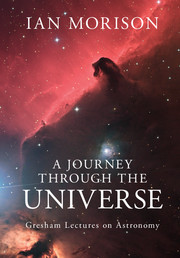Book contents
- Frontmatter
- Dedication
- Contents
- Preface
- Acknowledgements
- 1 Watchers of the skies
- 2 Our Sun
- 3 Aspects of our Solar System
- 4 The rocky planets
- 5 The hunt for Planet X
- 6 Voyages to the outer planets
- 7 Harbingers of doom
- 8 Impact!
- 9 Four hundred years of the telescope
- 10 The family of stars
- 11 Aging stars
- 12 The search for other worlds
- 13 Are we alone? The search for life beyond the Earth
- 14 Our island Universe
- 15 Wonders of the southern sky
- 16 Proving Einstein right
- 17 Black holes: no need to be afraid
- 18 It’s about time
- 19 Hubble’s heritage: the astronomer and the telescope that honours his name
- 20 The violent Universe
- 21 The invisible Universe: dark matter and dark energy
- 22 The afterglow of creation
- 23 To infinity and beyond: a view of the cosmos
- Index
- Plate section
- References
8 - Impact!
Published online by Cambridge University Press: 05 October 2014
- Frontmatter
- Dedication
- Contents
- Preface
- Acknowledgements
- 1 Watchers of the skies
- 2 Our Sun
- 3 Aspects of our Solar System
- 4 The rocky planets
- 5 The hunt for Planet X
- 6 Voyages to the outer planets
- 7 Harbingers of doom
- 8 Impact!
- 9 Four hundred years of the telescope
- 10 The family of stars
- 11 Aging stars
- 12 The search for other worlds
- 13 Are we alone? The search for life beyond the Earth
- 14 Our island Universe
- 15 Wonders of the southern sky
- 16 Proving Einstein right
- 17 Black holes: no need to be afraid
- 18 It’s about time
- 19 Hubble’s heritage: the astronomer and the telescope that honours his name
- 20 The violent Universe
- 21 The invisible Universe: dark matter and dark energy
- 22 The afterglow of creation
- 23 To infinity and beyond: a view of the cosmos
- Index
- Plate section
- References
Summary
An image of the Moon is a salutary reminder that bodies in the Solar System, including the Earth, have suffered millions of impacts in the past – and will continue to do so, but happily at a far reduced rate. If anything, due to its greater mass, the Earth will have suffered more impacts than the Moon but erosion has removed the evidence of all but a few from its surface. The impacts of Solar System debris, such as asteroids and comets, give rise to what are termed ‘impact craters’, a name that can be applied to any depression resulting from the impact at very high velocity of an object into a larger body. Impact craters are approximately circular depressions that usually have raised rims, and range from small, smooth, bowl-shaped depressions to large craters having terraced rims often with a central peak or peaks. Massive impacts give rise to giant impact basins such as the ‘mare’ on the Moon, where the lunar crust was breached and so lava was able to well up from below and fill the depression caused by the impact. These ‘mare’ depressions, also seen on Mercury, were the result of a period of intense bombardment in the inner Solar System that ended about 3.8 billion years ago. Since then, though still appreciable, the rate of crater production within the inner Solar System has been considerably lower, but about every million years the Earth experiences a few impacts large enough to produce 20-km diameter craters. Erosion on the Earth quickly destroys these, but about 170 terrestrial impact craters have been identified. Their size ranges from a few tens of metres up to about 300 km in diameter. Most are less than 200 million years old.
Until the 1930s it was widely believed that the craters found on the Earth were volcanic in origin rather than the result of impacts, and it was not until the 1960s that researchers, notably Eugene M. Shoemaker, found clear evidence that they had been created by impacts, identifying, for example, shocked quartz that could only be formed in an impact event. By 1970, more than 50 impact craters had been found on the Earth.
- Type
- Chapter
- Information
- A Journey through the UniverseGresham Lectures on Astronomy, pp. 100 - 117Publisher: Cambridge University PressPrint publication year: 2014



